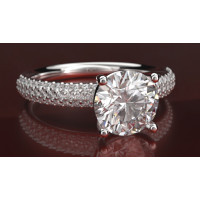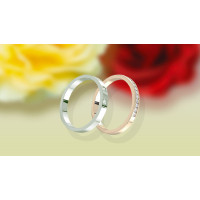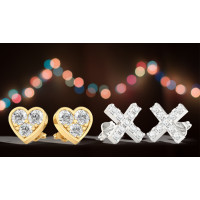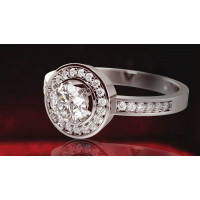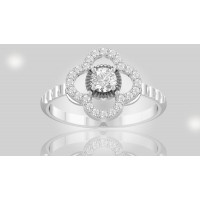types of diamond settings
-700x400.jpg)
Diamonds are set using different setting styles and techniques. The overall look of the stone depends heavily on the setting used. For instance, the prong setting enhances the shine of the diamond due to greater light refraction. Read on to discover a wide array of setting styles and designs.
Prong setting
This is one of the most popular choices for setting loose gems. In this style, the diamond is mounted relatively higher than it would have been normally done. This allows a lot more light to pass through the gemstone, creating a dramatic effect. Also known as the claw setting, it minimizes the amount of metal used in the jewellery. This classic setting is generally used to set princess cut diamonds..jpg)
Pave setting
A pave setting is actually used in crafting engagement rings. The diamonds are set low and held together using small “beads”. The gems are placed closely on the surface, in clusters, forming a continuous chain of diamonds. This style creates a brilliant sparkling effect and is perhaps the most elegant of all the settings
out there..jpg)
Channel setting
This setting is a very versatile one-it can be used for all cuts like round, princess, Asscher, etc. The diamonds are secured in place against vertical metal walls, forming a channel in which the gems are nestled close together.
Bar Channel Setting
The diamonds are placed between metal bars and secured in place using grooves at the top and bottom. The space between the gemstones allows adequate light to pass through the diamonds. This setting style works great for engagement rings or wedding bands.
Bezel setting
A metal strip encircles the diamond which is set deep inside it. The stone appears to be embedded in the metal, creating an illusion of a larger stone and increased prominence. Note that the bezel setting tends to be more expensive than the other settings as it requires higher expertise and a considerable amount of metal..jpg)
Half bezel setting
It’s easy to get confused between a bezel and a half bezel setting. Technically, both are the same. The only difference is that in a half bezel setting, the diamond is surrounded by a metal rim that is left open at the edges. By leaving the edges uncovered, one can flaunt the distinctive cuts and angles of the precious gemstones.
Tension setting
This setting uses compression to secure the gemstones in place. The minimal metal and unique placement create an illusion of a diamond floating over the band itself. The tension setting is not a traditional setting; it's highly unusual and unique in its appearance. Tension-set diamonds demand a specific skill set and high expertise which is why they tend to be in the steeper range of prices.
Fishtail setting
The diamonds are set very low in the metal strips and are secured in place using tiny beads. When seen from the above, the metal groves look similar to fishtails. This is one of the most sophisticated setting styles out there. It is the perfect portrayal of skillful craftsmanship. Unfortunately, this style has not gained much popularity like all its other siblings.
For more beautiful styles and designs, make sure to visit our website miorola.com
Related Posts
How to choose the best diamond for a Proposal
Diamond is best for Ring? When it comes to diamonds, there are many options to choose from. Finding the one that’s perfect for you could be confusing. You might get overwhelmed with the variety of options available in the market if you want a diamond ring for an engagement or planning a diamond ring proposal. So how do you choose the diamond for the ring? We tell you. Choose the correct shape The first step involved in buying a diamond for a ring for wom..
How to propose your girlfriend
How can I propose to my girlfriend?: Proposing your girlfriend can be overwhelming, as there is the pressure of getting it right the first time. Girls dream about their wedding proposal from when they are little. This may add to the pressure. However, with the right idea, a bit of planning and a little help, you can stage a proposal that you both will remember for days to come and may even tell your kids about. We help you out with a few popular ideas on how to go down on one kn..
What do you say in a wedding proposal
What do you say in a wedding proposal?: Getting down on a knee while holding a wedding ring says it all. But, the moment should be etched in your memories forever. Therefore, you need to have some eloquent words prepared. We give you some tips on what to say in a wedding ring. Prepare what you want to say: You need to prepare and practice what you are going to say when you go down on your knee with the wedding ring. You can write it down on a piece of paper and rehearse it..
What is the price of a real diamond ring
How much is a real diamond ring? So you have finally decided to pop the question. Now, it is time to get a diamond ring, because a proposal is simply incomplete without one. But, before that, you need to consider your budget and then decide which ring to go for.Read on to know more about the cost of diamond rings. The simple ringThese are simple gold bands with a diamond or floral motif with diamonds in them. A simple ring can start from Rs. 50,000 and can go to upwards of a lakh. The diamo..
Which Type Of Ring Will Work Best As An Engagement Ring
Engagement rings Offer a wide range of mesmerising styles, designs and cuts to choose from. When faced with thousands of options, the selection process turns into a rather tiring affair from the fun activity it was meant to be. It becomes really hard to zero in on one design with countless styles right in front of you. To avoid an unnecessary hassle, it is always better to shortlist some of the designs, that might suit your fiancé’s tastes. While some might go for a classic engagement rin..
Which Is The Best Diamond For An Engagement Ring
In the dynamic, everchanging world of fashion, a style that has managed to stand the test of time, is the all-time classic round- cut diamond engagement ring. For decades, round diamonds have always been the popular choice for an engagement ring. If you are thinking of getting the ultimate best for your loved one, then definitely go for a round-cut stone. So, what makes these diamonds so special and why should they be your top pick? Read on further, to understand why these diamonds are ..
